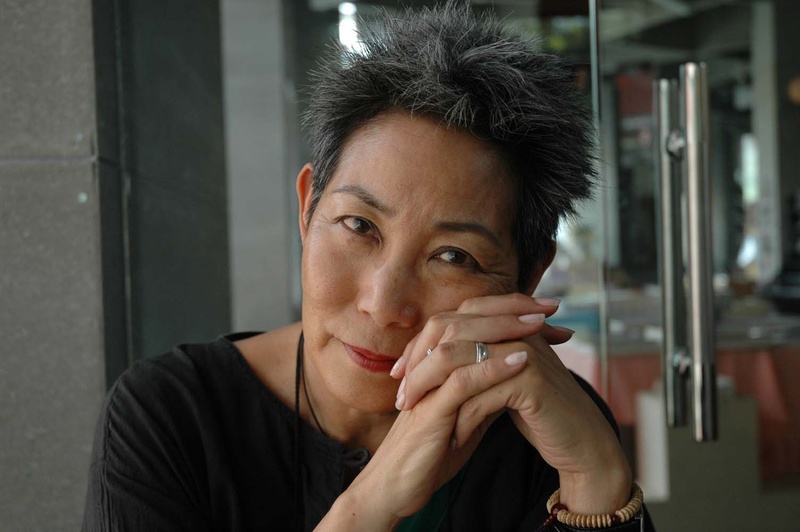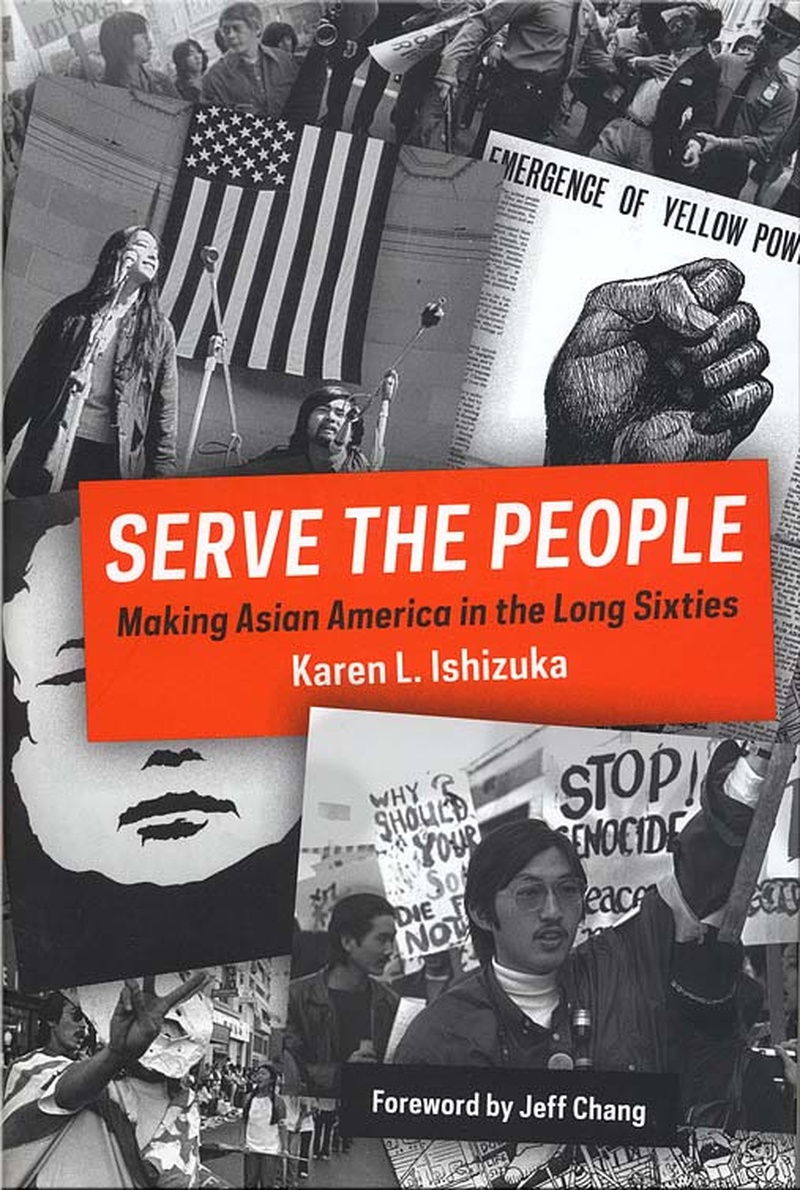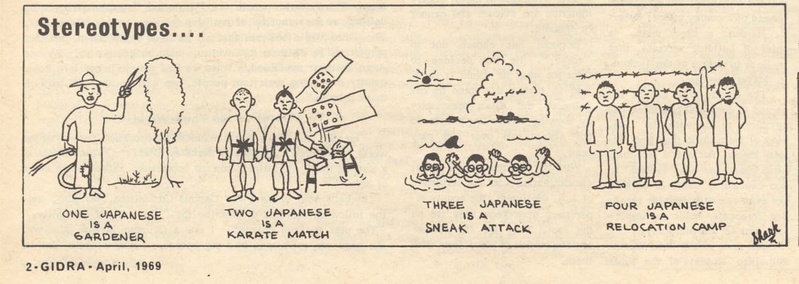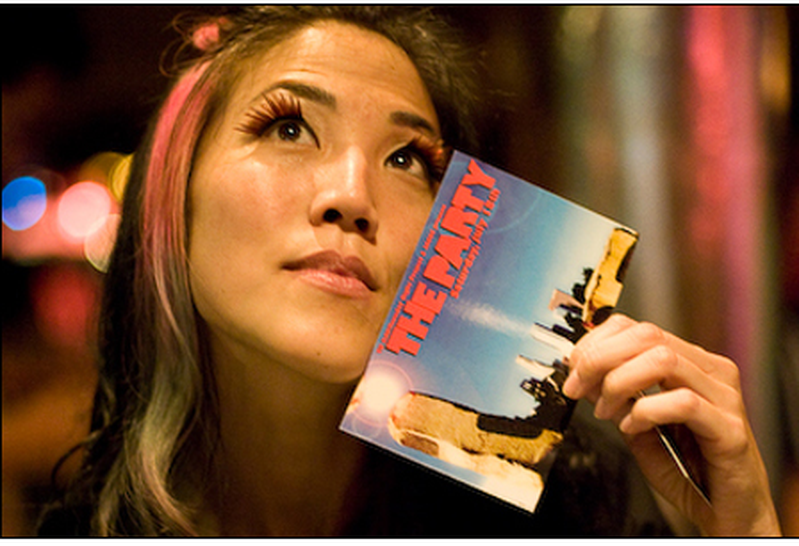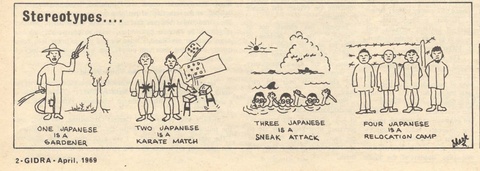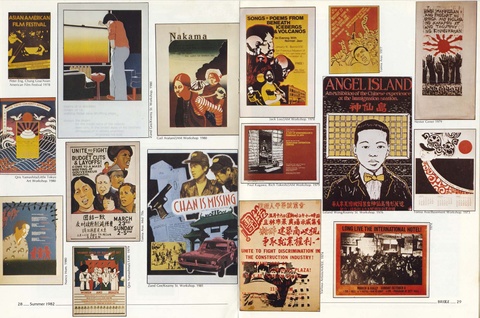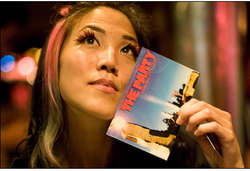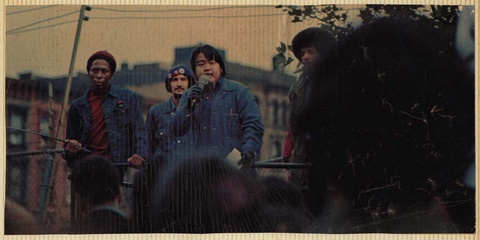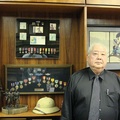“You have to keep changing, because what has happened and what you have been a part of is no longer there. The ideas that we develop remain in our heads … So our challenge constantly is both to learn from the past and also not be bound by the past.”
—Grace Lee Boggs1
The words of the late political thinker and activist Grace Lee Boggs offer a good reminder that in our struggles for personal and collective transformation, we must indeed learn from the past and also adapt to the changing material conditions of our own experiences. What, then, might we learn from the Asian American movement (the AAM or “the movement” for short), the constellation of community groups, intellectuals, artists, and all kinds of other people who engaged in different forms of activism, art, and political participation in the 1960s, 1970s, and 1980s?
To help us think through this question, Karen L. Ishizuka’s most recent book, Serve the People: Making Asian America in the Long Sixties (Verso, 2016) presents a comprehensive, narrative-centered retrospective of the Asian American movement. Ishizuka’s book offers an expansive recounting of, and reflection on, what transpired during that era so that we might consider its meanings for today.
Serve the People presents an engaging social history of the AAM that centers the stories, experiences, and reflections of the people who participated in the movement in different communities, settings, and contexts. Drawing on approximately 120 interviews conducted with Asian American movement participants throughout the United States over eight years, Serve the People makes clear the nuances of geography, time, and personal experience in the movement. Importantly, Serve the People speaks to a broad audience of academic, community, and activist readers from varying backgrounds and contexts.
The stories in Serve the People are wide-ranging and capture the various ways in which the Asian American movement took local form in places ranging from Kalama Valley in Hawai‘i to the International District in Seattle and the International Hotel in San Francisco’s Manilatown to Confucius Plaza in New York City. “Some of the people I talked with were movers and shakers, and others were grunts, the proletariat of movement,” Ishizuka said. “All were makers of history.”
These “makers of history” include Mike Nakayama, who testified at the Winter Soldier hearings in 1971 about how US soldiers mistreated the Vietnamese and also how Asian American soldiers were used as examples of what the enemy in Vietnam looked like.2 These “makers of history” also include Chris Iijima, movement troubadour, who remembered how much fun the movement was in the first place:
Part of the reason people were attracted to the movement may not have been the politics, but it’s where it was happening. It was where the party was! It was a blast! And I think that’s what we never talk about—what a great amount of fun it was! That gets lost sometimes, and we have to remember that.3
Reflecting on the process of finding people to interview and capturing movement stories, Ishizuka discussed beginning in familiar places: “I couldn’t talk with everyone, obviously, nor cover all the places the Asian American movement sprouted in. Originally I included the obvious hotspots—the San Francisco Bay Area, Los Angeles, and New York, and then added Hawai‘i, because it so often gets left out, and Seattle, where I discovered some early and little known stories.” These stories included those of Bob Santos, a longtime community activist in Seattle’s International District; and those of Gene Viernes and Silme Domingo, Filipino American labor activists who worked in the canneries and who were murdered in 1981 for their opposition to the Marcos dictatorship in the Philippines.
For Ishizuka, a Sansei film producer, curator, writer, and scholar (one who recently earned a Ph.D. in anthropology from UCLA), the unit of analysis has always been the story. “What distinguishes my book from the handful of others on the Asian American movement perhaps is the personal stories that together, tell not only what happened—the history—but how it felt to develop a new world—Asian America.” Ishizuka reflected, “Personal stories—life history, life stories, biographies, memoirs—have always been key in my work as an anthropologist, filmmaker, writer. I produced a film on Issei photographer Toyo Miyatake for JANM [Japanese American National Museum] and have written profiles of Don Nakanishi and Kazu Iijima that were published in Amerasia Journal. Even as a kid, my favorite books were biographies and a historical series called ‘You were there,’ or something like that, that told history from a first person point of view.”
Indeed, the stories that lie at the heart of Serve the People help readers make sense of the particular social, cultural, and political conditions from which the Asian American movement emerged in the late 1960s. In the foreword to the book, journalist and cultural critic Jeff Chang writes, “Serve the People is a history of what it felt like to live in those times—from the intensity and ecstasy of the period of discovery to the terror and betrayal of the spent revolution.”4 For Ishizuka, Jeff Chang’s words ring true. “It is this sense, ‘of what it felt like to live in those times,’ that I attempted to capture in the book,” Ishizuka said.
“While every person I interviewed would maintain that the AAM was greater than their part in it, a movement doesn’t make itself,” Ishizuka noted. “People do. And social movements are more than demonstrations and demands, political slogans and ideologies. They begin with individual epiphanies—‘a-ha moments’ that turn up the volume, demanding to be heard.”
These “a-ha moments” happened everywhere. Nancy Hom was studying to become a gallery artist in New York when she first heard Chris Iijima and Nobuko (JoAnne) Miyamoto sing about garment workers, railroad laborers, people like Nancy’s parents. Nancy went on to become a community artist and helped to grow the Kearny Street Workshop in San Francisco.5 Like most others who joined the movement, Mary Choy, a second-generation Korean American, had been politicized by the anti-Vietnam War movement and the struggle for ethnic studies at the University of Hawai‘i. Choy would go on to participate in organizing efforts to fight the mass evictions of small farmers in Kalama Valley in Hawai‘i in the early 1970s.6 After learning more about the Vietnam War for himself, Harvey Dong dropped out of the ROTC program at UC Berkeley and began actively participating in the anti-war movement.7
Serve the People is a product of over a decade of work. It had its beginnings in the early 2000s, when Ishizuka initially had two ideas for projects related to the AAM—one that focused on its cultural productions, and another that specifically highlighted Gidra, a prominent AAM newspaper based out of Los Angeles and notably, the longest-running movement paper, lasting from 1969 to 1974. In Serve the People, a comprehensive trade book that addresses the Asian America movement broadly, Ishizuka manages to incorporate analyses of its artistic and cultural productions (including the wide array of posters, photographs, films, and literary works) as well as Gidra’s content and images, which showed how the movement unfolded in the late 1960s and early 1970s.
At various appearances and book talks, Ishizuka has intentionally brought her book into conversation with local activists. When Ishizuka presented her book at the Howard Zinn Book Fair in San Francisco, Miriam Ching Louie, Belvin Louie, Nancy Hom, and Kori Saika Chen joined her and spoke to the importance of understanding the meanings that movement activisms have on the present. Harvey Dong and Peggy Saika joined Ishizuka when she was the closing keynote speaker at the Asian Pacific Student Development conference at UC Berkeley and Laureen Chew and Spencer Nakasako participated when Ishizuka addressed the students fighting for Ethnic Studies at San Francisco State.
At UCLA, she was joined by author-activist Diane Fujino, who wrote biographies on Yuri Kochiyama and Richard Aoki. In Seattle, Bob Santos, Frankie Irigon, and Sharon Maeda joined Ishizuka at the Elliot Bay Book Company, University of Washington, and South Seattle College. At the June 18th event at the Japanese American National Museum, Ishizuka will be in conversation once again, this time with local activists Warren Furutani, Mike Murase, Qris Yamashita, and traci kato-kiriyama.
Serve the People has received positive reception from a variety of readers—both Asian Pacific Islander and others—from around the country. “The audiences for the book talks has been very diverse,” Ishizuka said. “And at all of them, many API [Asian Pacific Islander] activists, many whom I would have liked to interview, came. And that has been very gratifying—to have it well-received by the people I wanted to highlight.”
Ishizuka also fondly discussed hearing from veteran activist Bob Santos about the book when it was published: “When such an icon as Uncle Bob wrote to me that my book chronicled his life, listed the names of more than 20 people in the book he knew and worked with, and that I had ‘nailed it,’ it was a validation beyond which any outside reviewer could convey.”
In addition to the meanings of the movement that Serve the People has brought to a general readership, the process of putting this book together has also been a journey with personal meaning for Ishizuka herself.
“This first person, personal approach made me privy to not only such awesome—and awful—stories, but to the personalities and hospitalities of people I interviewed,” Ishizuka said. “I got to know old friends better and make new friends in the process. In this way it was a tremendously meaningful experience for me—one that has truly enriched my life.”
Since Serve the People came out earlier this year, Ishizuka has continued to keep busy with various appearances and projects. In February, Ishizuka delivered a keynote speech that discussed the dangers of the continued use of euphemisms like “internment” (rather than “incarceration”) at the Gardena Valley Japanese Cultural Institute’s Day of Remembrance. Recently, in April, she raised the same issue as a guest on Democracy Now! In 2015, Ishizuka completed her Ph.D. dissertation on Gidra as an example of the significance of the dissident press on social movements.8 She plans to use her dissertation as the basis for a future book, and has other written pieces in the pipeline, including an essay called “Kill that Gook, you Gook!” in a forthcoming Routledge anthology on the Global Sixties.
Notes:
1. Grace Lee Boggs in Grace Lee, “Rest in Power, Grace Lee Boggs. 1915-2015,” memorial video, March 2016, accessed June 14, 2016, http://americanrevolutionaryfilm.com/memorial-film/.
2. Karen L. Ishizuka, Serve the People: Making Asian America in the Long Sixties (London and New York: Verso, 2016),106.
3. Chris Iijima, quoted in Ishizuka, Serve the People, 219.
4. Jeff Chang, foreword to Serve the People: Making Asian America in the Long Sixties, by Karen L. Ishizuka (London and New York: Verso, 2016), xi.
5. Ishizuka, Serve the People, 139-140, 214-215.
6. Ishizuka, Serve the People, 174.
7. Ishizuka, Serve the People, 99.
8. Karen L. Ishizuka, “Gidra, the Dissident Press and the Asian American Movement: 1969-1974,” PhD dissertation, University of California, Los Angeles, 2015.
* * * * *
On Saturday, June 18, 2016, at 2:00 p.m., author Karen L. Ishizuka will talk about her latest book, Serve the People: Making Asian America in the Long Sixties, and the Asian American Movement in Los Angeles at the Japanese American National Museum.
Featured will be three activists included in her book: Warren T. Furutani, an educator and politician who is currently in the running for California State Senator; Mike Murase, attorney, current Director of Service Programs for the Little Tokyo Service Center (LTSC), and co-founder of the UCLA Asian American Studies Center; and Qris Yamashita, a graphic designer and artist whose unique graphic style helped to form a visual identity for the Japanese American and Asian Pacific American community. Also joining the panel will be traci kato-kiriyama, artist, educator, community organizer, and co-founder of Tuesday Night Project, a free public program dedicated to presenting AAPI artists and community organizations. The program is free with museum admission.
For more information on this program:
janm.org/events/2016/06/18/serve-the-people
facebook.com/events/153417918406019
© 2016 Lawrence Lan


